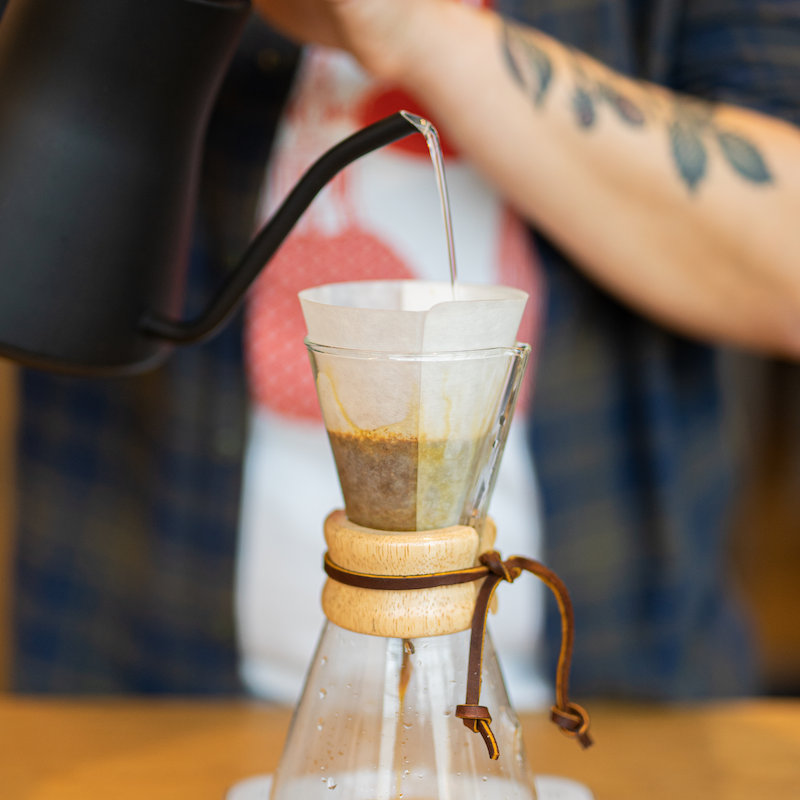The Chemex is one of those captivating items in the world of coffee. It’s probably not the most practical brewer, and its design can be a bit divisive, yet it’s probably one of the most iconic coffee brewers of all time. It was invented in 1941 by German inventor Peter Schulbohn, and very quickly captured the American market, even making it onto the front page of the Museum of Modern Art’s “Useful Objects in Wartime” magazine, being praised for its straightforward design. Its endurance as a design classic is attested by the fact that it’s still part of the MoMA collection. It’s certainly a gorgeous piece that makes your coffee look fantastic.

At first, the Chemex probably seems similar to most other hand pour-over brewers, but there are a few peculiarities. Most obvious are the papers. Rather than the classic cone shaped, pre-folded filter with a seam down one side that you open up and place directly onto the brewer, Chemex filters come as a large sheet that needs to be origamied into shape. The filter is folded in half, and then in half again, leaving a sealed cone when opened up. This does mean that there are three layers of paper on one side of the cone, which, combined with the fact that the Chemex filters are just plain thicker than regular coffee filters, means that brews run slightly different than normal filter brewers, as this set up provides much more resistance. This means you brew will be cleaner, with more fine particles and oils filtered out, but also that it will run a little slower. You might want to grind a little coarser to compensate for this, but don’t worry too much if your brews take a little longer than in other pour-overs.
The other key difference is in the design: it combines brewer and receptacle in a single piece. Rather than say a V60 where you have a cone that is placed over a cup or a jug, the Chemex brews in the funnel at the top, and, when you’re done, you pull out the filter and serve through the same funnel. This can present a problem: if the wet filter creates too tight a seal on the glass, it can create a kind of air-lock that prevents water from flowing down into the base. The pouring spout runs the length of the cone is there for a reason – it creates a channel for air to get through, but you can aid this by placing the 3-ply side of the filter on the same side as the channel, creating a stiffer filter wall that’s less likely to slip into the channel and choke the brew. You won’t necessarily have any problems, but it’s something to keep an eye on.
SO: HOW'S IT DONE?
30g Coffee, medium grind (EK43: 13 on the new dial)
500 g Water






STEP BY STEP
- Put the kettle on.
- Fold the filter per the instructions: they vary from model to model. Open out the filter into a cone shape.
- Place the filter into the brewer, with the 3-ply side on the side with the spout to prevent choking.
- Rinse out the paper with a good amount of boiling water to remove any papery flavours. Don’t forget to pour out this water.
- Put the coffee into the filter, level it out with a little shake, and then place the whole thing onto a set of scales and tare it out.
- Start the timer and pour in 60g of water, aiming to get all the coffee wet.
- Leave to bloom for at 45 seconds. Give it a little swirl if you feel not all the coffee is saturated.
- Now comes the main pour. We want to get 60% of our brew water in – so 300g – by about 1:15-1:30. Pour in concentric circles to cover the entire bed of coffee, not too hard, not too gentle. You want to agitate the coffee enough to make sure it’s all taking part in the brew, but not so much that you create a channel where water can rush through without hitting all the coffee.
- The funnel will now be fairly full. Continue to add water in small, controlled, circular pours. You should have the full 500g in by about 2:00-2:30.
- Give the Chemex a final, gentle swirl to knock any coffee off the sides and give a nice, level bed for the remaining water to drain through. Don’t worry if it takes even as long as 5 minutes to fully draw down.
- Pull the filter out and admire your hard work.





